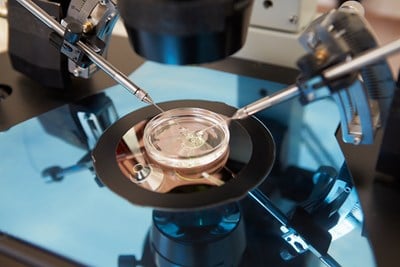In vitro fertilization (IVF) is a reproductive technology that can be used to treat various types of infertility. IVF is a process that involves several steps, including ovulation induction, egg retrieval, sperm retrieval, fertilization, and embryo transfer.
Because it is such a complicated process, a single cycle may take up to two weeks to complete. It is also important to keep in mind that more than one cycle of in vitro fertilization may be required before you successfully become pregnant. Here is what you can expect to throughout each stage of the IVF process.
Ovulation Induction
Each month, your ovaries will naturally produce a single egg. However, when you are undergoing fertilization techniques such as IVF, multiple eggs are needed because some won’t fertilize or will have problems developing after fertilization. In order to stimulate your ovaries to produce multiple eggs, your doctor will start you on a medication with synthetic hormones. There are several different medications designed for this purpose, and you may need to take more than one. They include:
- Ovarian stimulation medications: These medications work to stimulate the development of more than one egg at a time.
- Oocyte maturation medications: These medications help the eggs mature faster.
- Premature ovulation prevention medications: These medications are designed to prevent your body from releasing the eggs too soon.
- Medications to prepare the lining of your uterus: These medications make the lining of your uterus more receptive for implantation.
Usually, this stage of the process will take between one and two weeks. Vaginal ultrasounds and blood tests will be used to determine when the eggs are ready for retrieval.
Egg Retrieval
This procedure is performed in a clinic or doctor’s office. Transvaginal ultrasound aspiration is the most common method used for egg retrieval. This involves inserting an ultrasound probe into your vagina and identifying follicles. Once the follicles are identified, a thin needle is inserted into the follicles to retrieve the eggs using a suction device.
If your ovaries are not accessible through transvaginal ultrasound, then eggs may be retrieved during a laparoscopy instead, which involves making a tiny incision near your naval and inserting a small viewing instrument to guide the needle.
The removal of multiple eggs takes about 20 minutes. You may experience some cramping and pressure after the procedure is complete. After the eggs are successfully retrieved, they are placed in a nutritive liquid and incubated.
Sperm Retrieval
If you intend to use your partner’s sperm, then a semen sample will need to be provided the morning of the egg retrieval. Sometimes testicular aspiration, which uses a needle to extract sperm directly from the testicle, is necessary instead. Another option would be to use donor sperm. No matter how the semen is received, it will go through a process in the lab to separate the sperm from the other proteins in the semen fluid before fertilization.
Fertilization
This step of the IVF process is generally attempted through one of two common methods. The most popular method is insemination, which involves mixing healthy sperm and mature eggs and incubating them overnight. Another method that is recommended for couples who have already had failed fertilization attempts would be intracytoplasmic sperm injection (ICSI), which involves injecting a single sperm directly into each mature egg.
Other methods may be recommended for special circumstances, such as assisted hatching to help the embryo implant into the lining of the uterus. This is usually done for older women. Preimplantation genetic testing is also an option if there is a likelihood that a parent might pass on a genetic defect. Embryos can be screened for certain genetic conditions and only implant the embryos that do not contain these genetic markers.
Embryo Transfer
Usually two to six days after egg retrieval, embryo transfer will take place at your clinic or doctor’s office. After being given a mild sedative, the doctor or nurse will insert a long, thin tube called a catheter into your vagina, through your cervix, and into your uterus. The catheter will have a syringe that contains the embryos attached to the end. The procedure is usually painless, but you may experience some mild cramping or light spotting afterwards.



